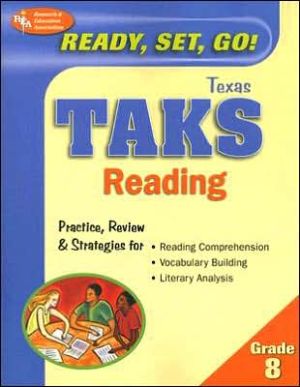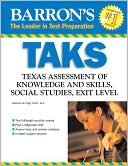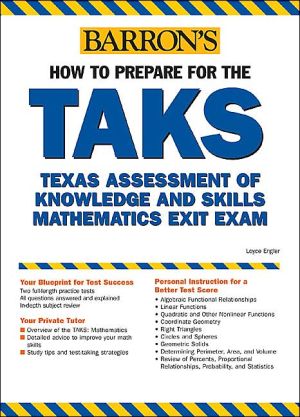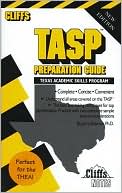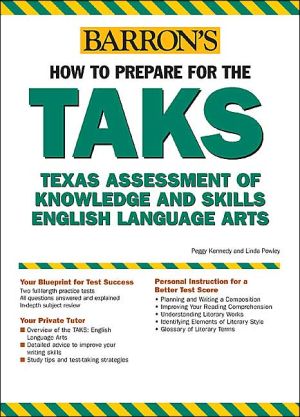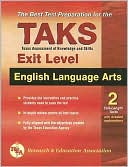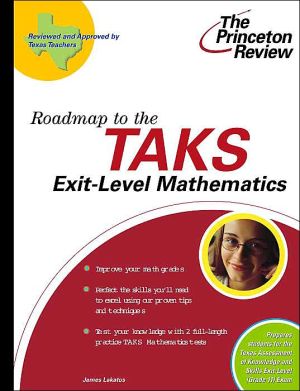TAKS 8th Grade Reading: The Best Test Prep for the TAKS
\ REA Real review, Real practice, Real results.\ \ REA's Texas Grade 8 TAKS Reading & Writing Study Guide!\ Fully aligned with the objectives adopted by the Texas Educaiton Agency\ \ Are you prepared to excel on this state high-stakes assessment exam? \ * Take the diagnostic Pretest and find out what you know and what you should know\ * Use REA's advice and tips to ready yourself for proper study and practice\ \ Sharpen your knowledge and skills\ * The...
Search in google:
REA … Real review, Real practice, Real results. REA's Texas Grade 8 TAKS Reading & Writing Study Guide!Fully aligned with the objectives adopted by the Texas Educaiton Agency Are you prepared to excel on this state high-stakes assessment exam? * Take the diagnostic Pretest and find out what you know and what you should know* Use REA's advice and tips to ready yourself for proper study and practice Sharpen your knowledge and skills* The book's full subject review refreshes knowledge and covers all topics on the official exam, including reading, literary analysis, and vocabulary to reinforce key English language lessons* Smart and friendly lessons reinforce necessary skills* Key tutorials enhance specific abilities needed on the test* Targeted drills increase comprehension and help organize study* Color icons and graphics highlight important concepts and tasks Practice for real* Create the closest experience to test-day conditions with a full-length practice Posttest* Chart your progress with detailed explanations of each answer* Boost confidence with test-taking strategies and focused drills Ideal for Classroom, Family, or Solo Test Preparation! REA has helped generations of students study smart and excel on the important tests. REA’s study guides for state-required exams are teacher-recommended and written by experts who have mastered the test.
SUCCEEDING ON THE TAKS—GRADE 8 READING\ ABOUT THIS BOOK This book provides excellent preparation for the Texas Assessment of Knowledge and Skills (TAKS)—Grade 8 Reading. Inside you will find exercises that are designed to provide students with targeted instruction, practice, and strategies—all of it with a single-minded focus: success on the TAKS.\ We have also made every effort to make the book easy to read and navigate.\ This book is divided into several parts. The first section is a PRETEST, which is half the length of an actual TAKS test and introduces students to some of the sections on the actual test, including a\ • narrative selection with 12 multiple-choice questions\ • paired selection (a biography and a narrative selection), with 12 multiple-choice questions\ Following the pretest is a lesson section, which teaches students about the different types of TAKS questions on the reading test, step by step. A full-length POSTTEST, which follows the lessons, includes detailed explanations of all answers.\ HOW TO USE THIS BOOK\ FOR STUDENTS: To make getting through the book as easy as possible, weve included icons shown on the next page that highlight sections like lessons, questions, and answers. Youll find that our practice tests are very much like the actual TAKS youll encounter on test day. The best way to prepare for a test is to practice, so weve included drills with answers throughout the book, and our two practice tests include detailed answers.\ FOR PARENTS: Texas has created grade-appropriate objectives that are listed in the table in this introduction. Students need to meet these objectives as measured by the TAKS. Our book will help your child review for the TAKS and prepare for the Reading exam. It includes review sections, drills, and two practice exams complete with explanations to help your child focus on the areas he/she needs to work on to help master the test.\ FOR TEACHERS: No doubt, you are already familiar with the TAKS and its format. Begin by assigning students the pretest. An answer key and detailed explanations follow the pretest. Then work through each of the lessons in succession. When students have completed the subject review, they should move on to the posttest. Answers and answer explanations follow the posttest.\ WHY STUDENTS ARE REQUIRED TO TAKE THE TAKS In 1999, the 76th Texas Legislature mandated that the TAKS be administered beginning in the 2002–2003 school year. The broad objectives of the TAKS are “umbrella” statements for the Texas Essential Knowledge and Skills (TEKS) that students must attain. Each of the four TAKS objectives applies to several TEKS student expectations. This book is designed to apply to both the broad TAKS and the individual TEKS student expectations.\ WHAT’S ON THE TAKS\ Reading Selections\ Reading selections on the TAKS target a culturally diverse audience. Four kinds of selections appear on the Grade 8 TAKS:\ 1. Narrative selections, which are fictional stories presented with a clear progression of events. Letters or diary entries, as well as stories, may represent narrative writing.\ 2. Expository (informative) selections, which provide information about noteworthy people and/or events or explain topics related to content areas such as science, social studies, art, or music.\ 3. Mixed selections, which combine two types of writing into a single passage. A mixed selection might include both factual information and invented dialogue.\ 4. Paired selections, which are two selections designed to be read together. Paired selections have a common theme.\ Selections in Grade 8 are approximately 700 to 1,000 words. Paragraphs within passages are numbered to aid the student in finding information.\ Reading Questions\ All questions of the Grade 8 TAKS Reading are multiple-choice. They assess the four objectives, which are detailed in the table on the following pages. The TEKS and corresponding student expectations are listed under each objective.\ The number of multiple-choice questions per objective is as follows:\ Objective 1: Basic understanding 12\ Objective 2: Literary elements 10\ Objective 3: Analysis using reading strategies 10\ Objective 4: Analysis using critical-thinking skills 16\ Total number of questions 48\ TAKS Reading Objectives*\ Objective 1: The student will demonstrate a basic understanding of culturally diverse written texts.\ (8.6) Reading/word identification. The student uses a variety of word recognition strategies. The student is expected to:\ (B) use structural analysis to identify words, including knowledge of Greek and Latin roots and prefixes/suffixes.\ (8.9) Reading/vocabulary development. The student acquires an extensive vocabulary through reading and systematic word study. The student is expected to :\ (B) draw on experiences to bring meanings to words in context such as interpreting [idioms], multiple-meaning words, and analogies;\ (D) determine meanings of derivatives by applying knowledge of the meanings of root words such as like, pay, or happy and affixes such as dis-, pre-, or un-;\ (F) distinguish denotative and connotative meanings.\ (8.10) Reading/comprehension. The student comprehends selections using a variety of strategies. The student is expected to\ (F) determine a texts main idea (or major) ideas and how those ideas are supported with details;\ (G) paraphrase and summarize text to recall, inform, or organize ideas.\ Objective 2: The student will apply knowledge of literary elements to understand culturally diverse written texts.\ (8.12) Reading/text structure/literary concepts. The student analyzes the characteristics of various types of texts (genres). The student is expected to\ (F) analyze characters, including their traits, motivations, conflicts, points of view, relationships, and changes they undergo;\ (G) recognize and analyze story plot, setting, and problem resolution;\ (J) recognize and interpret literary devices such as flashback, foreshadowing, and symbolism.\ *The test objectives presented in this table were created and implemented by the Student Assessment Division of the Texas Education Agency (TEA). For further information, visit the TEA website at www.tea.state.tx.us.\ Objective 3: The student will use a variety of strategies to analyze culturally diverse written texts.\ (8.10) Reading/comprehension. The student comprehends selections using a variety of strategies. The student is expected to\ (E) use the texts structure or progression of ideas such as cause and effect or chronology to locate and recall information;\ (I) find similarities and differences across texts such as in treatment, scope, or organization;\ (L) represent text information in different ways such as in outline, timeline, or graphic organizer.\ (8.12) Reading/text structures/literary concepts. The student analyzes the characteristics or various types of texts (genres). The student is expected to\ (A) identify the purposes of different types of texts such as to inform, influence, express, or entertain;\ (C) compare communication in different forms such as [contrasting a dramatic performance with a print version of the same story or] comparing story variants;\ (H) describe how the authors perspective or point of view affects the text.\ Objective 4: The student will apply critical-thinking skills to analyze culturally diverse written texts.\ (8.10) Reading/comprehension. The student comprehends selections using a variety of strategies. The student is expected to\ (H) draw inferences such as conclusions or generalizations and support them with text evidence [and experience];\ (J) distinguish facts from opinion in various texts.\ (8.11) Reading/literary response. The student expresses and supports responses to various types of texts. The student is expected to\ (C) support responses by referring to relevant aspects of text [and his/her own experience];\ (D) connect, compare, and contrast ideas, themes, and issues across text.\ (8.12) Reading/text structures/literary concepts. The student analyzes the characteristics of various types of texts (genres). The student is expected to\ (I) analyze ways authors organize and present ideas such as through cause/effect, compare/contrast, inductively, deductively, or chronologically;\ (K) recognize how style, tone, and mood contribute to the effect of the text.
About ReaviiAcknowledgmentsviiSucceeding on the Taks-Grade 8 ReadingviiiAbout this BookviiiHow to Use this BookviiiWhy Students are Required to Take the TAKSixWhat's on the TAKSxTAKS Reading ObjectivesxiTips for the StudentxiiiTips for ParentsxivPretest1Pretest Answers19Lesson 1Vocabulary23Passage 1The Caddo: Texas's Forest Dwellers25Passage 2Catching the Butterflies28Passage 3The Invisible Tree32Passage 4Get Ready to Battle the Common Cold, the Unbeatable Bug36Lesson 2Main Idea40Passage 1The Trail of Tears42Passage 2Madeleine's Twisty Treat45Passage 3Mosquitoes: Annoying but Amazing49Passage 4A Pop-ular Kind of Corn53Lesson 3Literature57Passage 1Excerpt from Bleak House60Passage 2The Bunkhouse63Passage 3Mr. Salazar66Passage 4Excerpt from The Secret Garden70Lesson 4Cause and Effect and Comparison and Contrast75Passage 1Clueless77Passage 2The Great Blue Heron80Passage 3Dragons of Ancient China84Passage 4Wilson Bentley88Passage 5The Art of a Snowflake88Lesson 5Author's Purpose and Point of View93Passage 1The Frame95Passage 2How to Set up an Aquarium98Passage 3Beating Writer's Block102Passage 4When Camels Came to Texas106Lesson 6Conclusions and Inferences, Part 1110Passage 1The Truth about Organ Donation113Passage 2Excerpt from Hard Times116Passage 3D.C. Dish119Passage 4The Loose Law of the Library123Lesson 7Conclusions and Inferences, Part 2127Passage 1The "Reality" of Reality Television128Passage 2The Dead Sea Scrolls131Passage 3A Costly Lesson134Passage 4Space Colonization: Too Big a Risk138Posttest143Posttest Answers171
